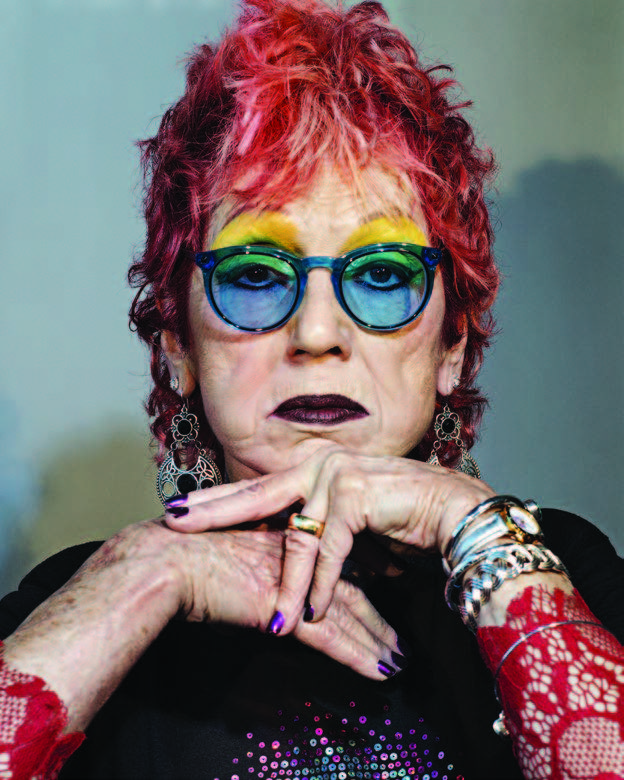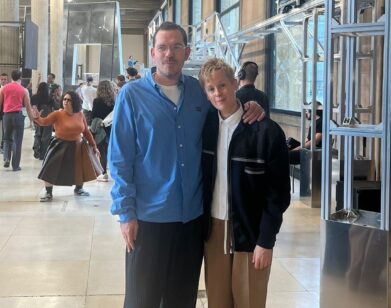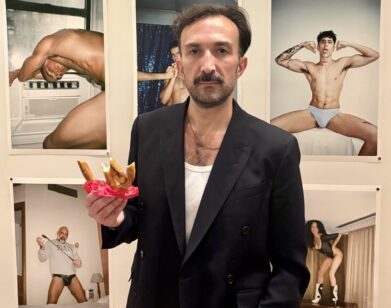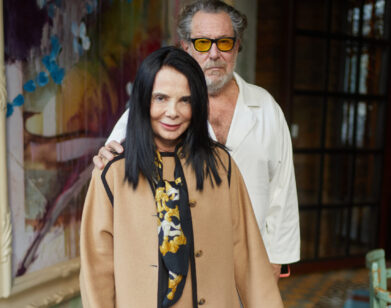Feminist art icon Judy Chicago isn’t done fighting
For ten years now, Judy Chicago’s 20th-century masterpiece The Dinner Party has been on permanent view at the Elizabeth A. Sackler Center for Feminist Art in the Brooklyn Museum. It’s become such a fixture there that it is hard to imagine the shock and vitriol the piece caused when it was first displayed in 1979, after four years and hundreds of hands went into its production. The Dinner Party went against so many mores, even by progressive art-world standards: it was overtly political, its content directly championing women’s rights and liberation; it was constructed not by an auteur but by a community; it was comprised of ceramics and needlepoint, “decorative arts” associated with feminine domesticity. Chicago’s sculpture was—and is—radical, correcting the boldfaced names of history while inspiring a new way of conceiving open, activist art production. Amid the straightforward concept of 39 increasingly vaginal place settings, each reserved for a different groundbreaking woman, Chicago and her team filled the triangular structure with so many symbols and allusions that the reading of the work never stops. (Each side of the triangle, for instance, holds 13 place settings, which is the same number of seats at both The Last Supper and of witches in a coven.)
While The Dinner Party is certainly the 78-year-old artist’s most well-known contribution to the volatile terrain of art history, it is by no means her only one. Chicago is not only a pioneer of feminist art; she is arguably its founder, inventor, and chief figurehead. While teaching at CalArts in the early 1970s, she created Womanhouse, a highly influential installation by a collective of female artists who turned a rental home into the site of charged feminist performances. In the mid-’80s, Chicago embarked on a series of acrylic and oil paintings whose subjects explored the aggression and arrogance of unchecked masculinity. Entitled “PowerPlay,” these works will be shown together for the first time in 30 years this January at Salon 94 in New York. Their relevance to today’s political and social climate only proves that Chicago’s message still needs to be heard and that there are still so many battles to wage for equality. Chicago now spends most of her time in New Mexico, but she was in New York for the opening of “Roots of The Dinner Party: History in the Making,” a look into the making of that now-iconic piece, and it was here that she spoke with her dear friend and comrade Gloria Steinem about how much—and how little—has changed.
JUDY CHICAGO: Hi, Gloria. How are you?
GLORIA STEINEM: On a scale of one to ten, about a seven.
CHICAGO: Me, too. I did a press preview today, and they can be exhausting. I hate when people say, “Have fun at the press preview.” Fun is talking to you.
STEINEM: You and I are always striving to cross the country and get together, so I appreciate that we’re finally getting to talk now.
CHICAGO: We’ve known each other for so long. Let’s start with our first encounter, which neither of us can be sure was an encounter at all. I didn’t know you had been at Womanhouse in the 1970s. I only found that out later.
STEINEM: I’m not 100 percent sure that you were physically present when I was there. We should probably explain what Womanhouse is.
CHICAGO: In the early 1970s, when I was teaching at CalArts, I was focused on creating a feminist art practice and a new form of art education. I started a program in Fresno, California, because I had to be away from L.A. in order to try it out. It was the first feminist art program, and I was invited to bring it to CalArts—except we didn’t have a space at the school, so instead we met in people’s living rooms. Eventually, thanks to the suggestion of Paula Harper, who was one of the first feminist art historians, we rented an old house in Burbank. There were about 20 students, and we turned the house into the first major feminist art installation. It was up for a month. There was a film made about it by Johanna Demetrakas, and Jill Soloway is now working on a TV project about it. There’s been a wave of recent interest. Amazon recently bought the rights to my first autobiography.
STEINEM: At some point during that month, I was fortunately traveling through L.A. and was able to walk through Womanhouse. It was a kind of thunderbolt moment for me of realizing, “Wait a minute, we have symbols, too.” I remember that there was a bedroom with a woman sitting at a mirrored vanity perpetually brushing her hair. There was a tub in the bathroom full of colored sand with a female figure in the tub, and a sign saying, “Please don’t touch the sand,” which made it irresistible. But once you touched the sand, nothing could remove the mark you made. It was the proof of vulnerability. I remember there was a bride going up a staircase.
CHICAGO: The bride was actually going down the staircase, and she ran into a wall.
STEINEM: [laughs] It had the familiarity of your home and place of birth and growing up and current living, so there was a circular impact—not just the linear impact that a canvas or a sculpture has. It had a profound impact on me.
CHICAGO: It has inspired projects all over the world. There’s even a digital Womanhouse and an exhibition of young artists influenced by it opening right now in Paris. Even though you and I likely didn’t meet at Womanhouse, our relationship goes back to the birth of feminist art. And now, here we are, both involved with the Sackler Center for Feminist Art.
STEINEM: One of the many rewards of age is seeing this growth of vines.
CHICAGO: It comes up a lot these days that young women run into obstacles that daunt them. We should discuss how we’re able to offer young people a model for how you can fight for change your whole life and not get discouraged. We watch again and again the very story The Dinner Party tells of erasure and pushing back. We still witness that after being part of a social movement where we actually felt we were going to make a permanent change.
STEINEM: In my case, it did feel like being struck by lightning when I first realized that I wasn’t crazy, that the system is crazy. I kept looking with new eyes, with hierarchy removed or at least questioned, and saying to myself, “This is so unjust and crazy and irrational that surely if we explain it to people they will want to change it.” That was a function of my naïveté because I was failing to see the depths of the entrenchment and the profiteering and the fact that, as they say with wisdom in Indian country, “It takes four generations to heal one act of violence.” What I didn’t understand at first was that being a part of a movement was not just a part of my life, it was my life. I say this to young women because I think it helps us to pace ourselves. We have to rest and jog and replenish and drink water and say hello to each other and have humor and companionship along the way. Also, we must understand that the end doesn’t justify the means—the means are the end. So if we don’t have a community and jokes and love and creativity along the way, we won’t have it at the end.
CHICAGO: One of the things I understood from early on was that art was a symbol of systemic inequity. The absence of women artists in our museums, or the marginalization of women in university curriculum, mirrors the everyday experience of women. In January, my New York gallery is going to show my series “PowerPlay” [1982–87], which is about the construct of masculinity. It’s going to be retitled “PowerPlay: A Prediction,” because what I think that women are beginning to see is a global system of male terrorism that is manifested in Afghanistan in stoning women who violate the canon, sequestering women, covering women; or in the Congo as systemic rape, as a weapon of war; and at a less severe level, sexual harassment and the abuse of power in Hollywood, in the military, and in the California legislature. The reason we have to do what you just described is because when we were working in the ’70s, we thought we were going to change everything right then and there. The Dinner Party tells that story of pushing forward, pushing backward, forward, backward—now we’re witnessing the pushing backward. I was just thinking about how I am sustained. You, Gloria, have a whole global network of support. I’ve been really isolated—I’ve had to be in order to think against the culture. But the stories of the women in The Dinner Party have sustained me. Their stories are stories of courage. I’m talking about figures like Elizabeth Blackwell, who was only admitted to medical school as a joke, and then endured two years of total isolation. Nobody spoke to her. Women spat at her on the street. I mean, what kind of courage did it take to stand up to that? If she could do it, I can do it. The 1,038 women represented in The Dinner Party offer an incredible path to courage and fortitude.
STEINEM: You seem to experience stories from history. I experience stories in the present, from different places in the world. I lived in India for two years, where I absorbed a populist, Gandhian revolution. When I went to visit a great global feminist of Gandhi’s era in the ’80s, I was talking about how well-suited Gandhian methods were to women’s movements. She listened to me patiently and finally said, “Well, my dear, we taught him everything he knew.” [laughs] It wasn’t really until the birth of the women’s movement in the United States that I could see that walking from village to village in India was a version of listening to women’s stories in living rooms here. Our brains are organized by narrative because we’ve been sitting around the campfire listening to stories for a hundred thousand years. I think it’s important to see the parallels, and to understand that our masculine and feminine roles are relatively new in human history. Both gender and race are inventions that go deep because we have been raised with them, but they are still inventions.
CHICAGO: One of the reasons for sharing these stories is to help imagine another future. One of the problems of being raised within a particular paradigm is that the education of that particular paradigm is presumed to be universal and there is no alternative.
STEINEM: Yes, which is utter bullshit. If we started to study humans when humans started, we would have a very different picture of what’s possible.
CHICAGO: My goal as an artist has been to create images in which the female experience is the path to the universal, as opposed to learning everything through the male gaze. The reason women spat on Elizabeth Blackwell was because they had been raised to believe that a woman doctor was obscene. The first step is freeing oneself from the prison of that gaze. While working on “PowerPlay,” I went to the library and looked up gender, and only women came up—as if only women had genders.
STEINEM: [laughs] That’s like saying only black people have race. It’s crazy.
CHICAGO: Absolutely! I think one of the real setbacks in the women’s movement was that women were more willing to raise their daughters as feminists than to teach their sons another way of being men.
STEINEM: I would add that women are only half responsible for children. Men raise children as much as women do. Until men are as nurturing as women are, and until women are as active outside the home as men are, we won’t have democratic families, and therefore we won’t have democracy, and we will continue this hierarchical notion of life.
CHICAGO: My husband, Donald, a truly radical man, talks about how men are rewarded for going along with the program, even if in their hearts they feel like the program is wrong and unjust and inequitable.
STEINEM: The men I know who are single fathers get much more help from the women around them, to put it mildly, than the women I know who are single mothers do from the men around them. You and I could go on forever on this subject. But let’s get back to The Dinner Party. It’s been showing for ten years now at the Brooklyn Museum, where I think I read that a million and a half people have seen it.
CHICAGO: I’m opening a show there called the “Roots of The Dinner Party,” which is the first look at my creative process in the making of it. The Dinner Party was shocking when it entered the world. It was female-centered art that took up a lot of space. As a result, it faced an uncertain future, even though it had traveled to six countries on six continents—that is, until Elizabeth Sackler intervened, acquired it, donated it to the Brooklyn Museum, and established the Elizabeth A. Sackler Center for Feminist Art. The only comparable institution is the National Museum of Women in the Arts in Washington, D.C., but these two small institutions can’t possibly accommodate all of the cultural production of women around the world.
STEINEM: I have to say, Judy, that since I’m a writer and only need a pencil, I have faced less adversity than you, whose creativity involves much more than that and is communal. I can report on people. Your practice involves an enormous level of different kinds of creativity.
CHICAGO: It’s no accident that in the three arts— literature, art, and music—literature was the first avenue in which women were able to excel because, as you said, it only takes a pencil and one other person, an editor who believes in you, to bring what you write into public view. In art, women could never get training. They couldn’t get their work out into the world even when they could get training. Music is the last of the three arts. For that, you need a huge apparatus of support.
STEINEM: I would add architecture, too.
CHICAGO: Of course! With architecture, you need millions and millions of dollars. Which leads me to a question to perfectly end this conversation: You once asked me what I would do if all monetary and geographic limits were lifted. So I’m asking you that, too.
STEINEM: I’d thought of that question for you before I thought of answering it myself! [laughs] I would love to see a kind of Alcoholics Anonymous system for women around the globe so that wherever women are, whether they are washing clothing on the rocks in a river in Rajasthan or in an office in England—wherever they are—they know that within their reach, not only online, but physically, there is a place every week where a small group of women, and men, too, if they are gathering in the feminist spirit, can meet to support each other, tell our stories, and suggest shared solutions. Movements grow like trees from the bottom up, not the top down. That’s how revolutions grow.
CHICAGO: Okay, my turn. If all the financial and geographic limits were lifted, I would separate art from commerce, and I would encourage artists around the world to make art that is accessible and understandable to the communities in which they live. I would encourage subjects relevant to their communities because I believe that art has incredible power. As long as it is linked to and controlled by marketplace values, communication is controlled and limited, and the power of human beings to make change and to make art that can contribute to change is prevented. Both of us have been working in our parallel ways to achieve these goals and that is why, even when we are apart, our lives represent parallel paths.







